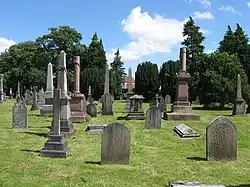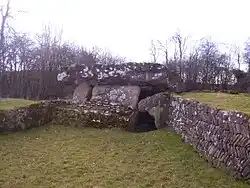
Welsh cemeteries refers to graveyards and cemeteries across Wales in the United Kingdom. These can be visited or records thereof consulted online as an element of studying a person’s family history or genealogy. People have been buried or cremated in Wales for thousands of years, though the vast majority of cemeteries in the country today date to the late medieval, early modern or modern periods, with most having been established in either the eighteenth, nineteenth or twentieth centuries. These include some of the country’s largest cemeteries like Cathays cemetery in the capital Cardiff and Oystermouth cemetery in Swansea.[1]
Research your ancestors on MyHeritage
History of Welsh cemeteriesHistory of Welsh cemeteries

As with virtually any country in the world, there are burial sites in Wales that date back thousands of years to the Neolithic or New Stone Age. One such is the Tinkinswood burial chamber outside the capital of Wales, Cardiff, which dates back to around 4000 BCE and is a dolmen like stone burial site.[2] Recently archaeologists uncovered the remains of a cemetery dating to the Early Middle Ages, around 600 CE, at Fonmon Castle in Wales.[3] And there are many small cemeteries in the country dating to the late medieval and early modern eras attached to Welsh churches and former monastic sites. However, the vast majority of cemeteries in Wales today are no more than 300 or so years old.

Most of the largest cemeteries in Wales today are the result of two social developments in the nineteenth century and a political development that they then spawned. Firstly, the Industrial Revolution of the late eighteenth century had led to a huge demographic shift in England and, to a lesser extent, in Wales, as people left the countryside and headed for the towns and cities to work in the new factories. At the same time improving living standards and the introduction of the smallpox vaccine led to a major population spike. As all of this occurred municipal governments needed ever greater amounts of land to bury the dead. The second social development was the arrival of waves of cholera to Britain from the 1830s onwards. As ‘the blue death’ killed tens of thousands of people across England and Wales, existing cemeteries filled up and people ran out of room to bury the dead.[4]
All of this in turn led to the political development. In 1852 the Metropolitan Burial Act was passed through the British parliament, setting out the mechanisms for the establishment of new cemeteries across England, Wales, Scotland and Ireland. Further legislation followed in the years ahead, but the initial act led to a wave of cemetery establishment. In Wales, some of the country’s largest cemeteries, including Cathays cemetery and Brecon cemetery, both opened in 1859, resulted from this concurrence of industrialization, urban growth, population expansion, the cholera epidemic and government reaction in the form of the Burial Acts.[5]
Welsh cemeteries and genealogical researchWelsh cemeteries and genealogical research
Cemetery records in Wales can be useful for genealogical research in terms of both establishing the death record of a family member and acquiring more personal details about the circumstances of their death. While visiting an actual cemetery has it merits, it is not always practical. Luckily, many Welsh cemetery records have been digitized in recent decades, with either the text of the headstone or grave-plaque transcribed or images of the grave created. A large tranche of these records can be consulted through interment.com.[6] Records of Welsh soldiers who served in the First World War and Second World War can be viewed through the Commonwealth War Graves resource on MyHeritage. Cemetery records for over a century and a half between 1840 and 2014 in Pembrokeshire are available through the Select Burial and Cremation Index on MyHeritage. The BillionGraves resource, an ever-growing repository of images of more than 40 million headstones worldwide, some from Wales, can also be accessed through MyHeritage.
Important Welsh cemeteriesImportant Welsh cemeteries

As with any large or mid-sized country, there are hundreds of cemeteries in Wales. Here are some of the largest and most historically significant:
- Cathays cemetery, Cardiff – Opened in 1859, Cathays cemetery serves the city of Cardiff, the capital of Wales, and is one of the largest cemeteries in Wales. An estimated quarter of a million people have been buried here over the years, though the exact number is unclear as the cemetery was damaged during German bombing raids at the time of the Second World War.[7]
- St Woolos cemetery, Newport – The main cemetery of Newport, the third largest urban center in Wales. After years of gradual development of the site, it came into use in 1854.[8]
- Llandaff cemetery, Cardiff – This is largely only in operation since the late nineteenth century, but there was a cemetery attached to Llandaff cathedral in Cardiff for generations before this and the modern-day cemetery is in many ways an extension of this. It closed to new burial in the 1960s and is somewhat grown over today.[9]
- Cefn Golau, Blaenau Gwent – A smaller cemetery, but one with a historic significance. It was used before the beginning of civil registration in Wales and also as a mass a grave, Cefn Golau having been established as an emergency cemetery to deal with deaths from the first cholera epidemic in Britain in the 1830s.[10]
- Brecon cemetery, Brecon – A major cemetery opened on the western side of the town of Brecon in 1859. It is noted for its two ornate nineteenth-century mortuary chapels.[11]
- Oystermouth cemetery, Swansea – One of the largest cemeteries in Swansea, the second city of Wales. It was opened in 1883.[12]
See alsoSee also
Explore more about Welsh cemeteriesExplore more about Welsh cemeteries
- England & Wales, Death Index, 1837-2005 records collection on MyHeritage
- United Kingdom, Select Burial and Cremation Index, 1840-2014 records collection on MyHeritage
- BillionGraves records collection on MyHeritage
- Amazing Ways to Use Death Records for Family History Research at the MyHeritage Blog
References
- ↑ D. Joshua Taylor, ‘The Genealogy Factor: Graveyards & Gravestones’, JSTOR Daily, 23 April 2015.
- ↑ https://www.visitwales.com/attraction/historic-site/tinkinswood-burial-chamber-cadw-1843268
- ↑ https://www.smithsonianmag.com/smart-news/this-medieval-cemetery-was-home-to-crouching-bodies-and-graveside-feasting-180983545/
- ↑ https://www.nationalarchives.gov.uk/education/resources/coping-with-cholera/
- ↑ D. E. Wiggins, ‘The Burial Acts: Cemetery reform in Great Britain, 1815–1914’ (PhD thesis, University of Texas, 1991).
- ↑ https://www.interment.net/uk/wales/index.htm
- ↑ https://www.findagrave.com/cemetery/2174767/cathays-cemetery
- ↑ https://coflein.gov.uk/en/site/266094/
- ↑ https://www.walesonline.co.uk/news/wales-news/cardiff-llandaff-cemetery-history-where-20878892
- ↑ https://coflein.gov.uk/en/site/403539/
- ↑ https://coflein.gov.uk/en/site/420978/
- ↑ https://www.swansea.gov.uk/oystermouthcemetery?lang=en

